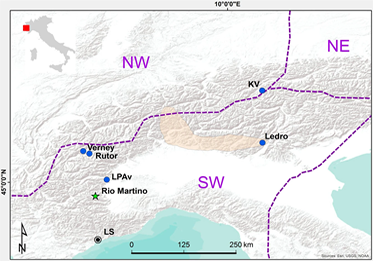Holocene Critical Zone dynamics in an Alpine catchment inferred from a speleothem multiproxy record: disentangling climate and human influences

Regattieri E., G. Zanchetta, I. Isola, E. Zanella, R.N. Drysdale, J.C. Hellstrom, A. Zerboni, L. Dallai, E. Tema, L. Lanci, E. Costa, F. Magrì (2019).
Nature – Scientific Reports, 9 , 1–9.
https://www.nature.com/articles/s41598-019-53583-7
Abstract
Disentangling the effects of climate and human impact on the long-term evolution of the Earth Critical Zone is crucial to understand the array of its potential responses to the ongoing Global Change. This task requires natural archives from which local information about soil and vegetation can be linked directly to climate parameters. Here we present a high-resolution, well-dated, speleothem multiproxy record from the SW Italian Alps, spanning the last ~10,000 years of the present interglacial (Holocene). We correlate magnetic properties and the carbon stable isotope ratio to soil stability and pedogenesis, whereas the oxygen isotope composition is interpreted as primarily related to precipitation amount, modulated at different timescales by changes in precipitation source and seasonality. During the 9.7-2.8 ka period, when anthropic pressure over the catchment was scarce, intervals of enhanced soil erosion are related to climate-driven vegetation contractions and occurred during drier periods. Immediately following the onset of the Iron Age (ca. 2.8 ka), by contrast, periods of enhanced soil erosion coincided with a wetter climate. We propose that the observed changes in the soil response to climate forcing were related to early anthropogenic manipulations of Earth’s surface, which made the ECZ more sensitive to climate oscillations.


Devi effettuare l'accesso per postare un commento.